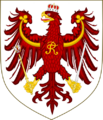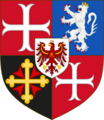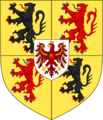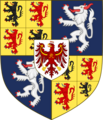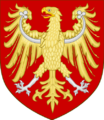House of Rahdenburg
| House of Rahdenburg | |
|---|---|
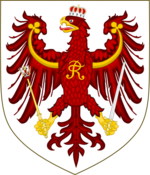 | |
| Country | |
| Etymology | Rahden Castle |
| Founded | before 921 |
| Founder | Eberhard of Rahden |
| Current head | William IV, Elector of Rahdenburg (2003–present) |
| Titles |
|
| Estate(s) | Garima, Latium, Schaumberg, Sydalon |
| Cadet branches | |
The House of Rahdenburg (Gariman: Haus Rahdenburg; Latin: Domus Radenburgensis) is a Gariman elector dynasty whose members were at times counts, margraves, princes, electors, grand dukes, and kings of Rahden, Rahdenburg, Schaumberg, and Sydalon. The family is believed to have originated from around X, Tervingia, in modern day Ostrovaza. They took their name from Rahden Castle, from where records indicate the family first ruled as Counts of Rahden before the formation of the Holy Audonian Empire.
The family rose to prominence in the years preceding the formation of the Kingdom of Garima, in which is was created Elector of Rahdenburg during the first expansion of Audonian electorates. It retained its elector status following departure of the Kingdom of Garima from the Holy Audonian Empire in 1603. In 1918, the House of Rahdenburg rebelled against the King of Garima, which led to its eventual attainder and exile. The family primarily resided in Latium throughout its exile, which ended in 1991 when the order of attainment was lifted by King Peter II following the marriage of his son then Conrad, Duke of Silingia and Margarethe of Rahdenburg.
County of Rahden
The most widely accepted progenitor of the House of Rahdenburg is Eberhard of Rahden, a count of Rahden that lived in the 9th century. It is also widely claimed and believed that Eberhard was a grandson of Guntram of Hulmul and the House of Hulmul, who constructed the original Rahden Castle. As a result, the Rahdenburgs claim descent from nobility in ancient Tervingia.
Senior branch
By the 13th century and the reign of Louis I, Holy Audonian Emperor, the House of Rahdenburg as counts of Rahden and counts of Sielhorst were created margraves of Rahdenburg. The first margrave as imperial prince was Frederick I. The house continued to remain influential in the Gariman lands of the Holy Audonian Empire, often battling for influence with other major families such as Nyrundy and Suedia. By the late 15th century with the reign of Henry IV, the family obtained lands in what is today the Duchy of Neuenburg. As the modern members of the House of Rahdenburg descend in the male-line from Elector Frederick VII, all living Rahdenburgs are also Sydalene princes of the blood, as Frederick VII was the paternal grandson of King Jordan VI of Sydalon.
Just prior to the separation of Garima from the Holy Audonian Empire, the margaves of Rahdenburg were elevated to the status of elector. By most contemporaries, this was seen as an attempt to placate Gariman nobility; however, it proved a failure when the electors of Rahdenburg instead joined Garima in 1600, becoming one of the original seven electors of Garima. The rulers of Rahdenburg were often seen as one of the leading Catholic electors and families in Garima following the reformation; however, they never succeeded in winning a royal election.
In 1918, the House of Rahdenburg rebelled against the reign of newly elected William IV of Garima, contesting the results of the 1918 Gariman royal election and establishing itself as anti-kings. The event known as the [] led to the downfall of the House of Rahdenburg, with the death of Electors Henry IV and then his son William II. The deaths of subsequent electors in battle, along with the writ of attainment issued by William IV resulted in the armies of Rahdenburg to scatter and members of the house to exile. The majority of surviving members of the house and its loyalists fled to Latium with Electress Diana, a princess of Latium by birth, where the family maintained a high place at court throughout their exile.
By 1990, the House of Rahdenburg persisted in Latium, and in some instances flourished with a number of high profile marriages and political relations throughout Belisaria and other Catholic nations. The Rahdenburgs were restored to their lands and status as electors in 1991 following the marriage of dynast Margarethe of Rahdenburg to the future Conrad IV of Garima. The current elector is William IV, whose son Constantine, Electoral Prince of Rahdenburg is his heir apparent. Should Constantine's son [name] eventually become elector, he will be the first elector of the House of Rahdenburg to be born in Rahdenburg since 1887.
Margraves of Rahdenburg
Electors of Rahdenburg
| Portrait | Name |
Reign | Birth | Death | Marriages | Relationship to predecessor |
|---|---|---|---|---|---|---|

|
Frederick V | 29 December 1567 – 9 May 1603 |
11 January 1534 | 9 May 1603 | also as Frederick V, Margrave of Rahdenburg | |

|
Frederick VI | 9 May 1603 – 30 July 1613 |
15 October 1564 | 30 July 1613 | Son of | |

|
Leopold I | 30 July 1613 – 11 August 1634 |
5 April 1591 | 11 August 1634 | Son of | |

|
Leopold II | 11 August 1634 – 7 May 1661 |
29 July 1610 | 7 May 1661 | Son of | |

|
Frederick VII | 7 May 1661 – 26 January 1704 |
29 July 1610 | 7 May 1661 | Great-nephew of | |

|
William I | 26 January 1704 – 21 February 1714 |
11 January 1666 | 21 February 1714 | Son of | |

|
Rudolf III | 21 February 1714 – 8 November 1739 |
30 January 1681 | 8 November 1739 | Son of | |

|
Ernst I | 8 November 1739 – 17 March 1753 |
21 March 1704 | 17 March 1773 | Son of | |

|
Conrad I | 17 March 1753 – 8 September 1780 |
6 April 1728 | 8 September 1780 | Nephew of | |

|
Matthias I | 8 September 1780 – 13 November 1805 |
2 June 1733 | 13 November 1805 | Cousin of | |

|
Matthias II | 13 November 1805 – 15 July 1827 |
22 February 1764 | 15 July 1827 | Son of | |

|
Otto IV | 15 July 1827 – 10 November 1871 |
3 November 1802 | 10 November 1871 | Gabriella of Sydalon | Son of |

|
Conrad II | 10 November 1871 – 26 June 1884 |
28 September 1831 | 26 June 1884 | Adela of Nyrundy-Robeck | Son of |

|
Henry V | 26 June 1884 – 7 September 1918 |
4 February 1857 | 7 September 1918 | Diana of Latium | Son of |

|
William II | 7 September 1918 – 22 November 1918 |
1 February 1887 | 22 November 1918 | Adalinda of Nyrundy | Son of |

|
William III (in pretense) |
22 November 1918 – 5 August 1977 |
9 April 1912 | 5 August 1977 | Margarita of Catana | Son of |

|
Otto V (in pretense until 1991) |
5 August 1977 – 30 May 2003 |
18 August 1932 | 30 May 2003 | Asimina of Lihnidos | Son of |
| File:William IV, Elector of Rahdenburg.jpg | William IV | 30 May 2003 – present |
6 January 1960 | Living | Constantia of Ravenna | Son of |
Order of succession
William II, Elector of Rahdenburg (1887–1918)
William III, Elector of Rahdenburg (1912–1977)
Otto V, Elector of Rahdenburg (1932–2011)
William IV, Elector of Rahdenburg (b. 1960)
- (1) Constantine, Electoral Prince of Rahdenburg (b. 1986)
- (2) William of Rahdenburg (b. 2010)
- (3) Leopold, Duke of Rahdenburg (b. 1990)
- (4) Theodore, Duke of Rahdenburg (b. 1993)
- (1) Constantine, Electoral Prince of Rahdenburg (b. 1986)
- George, Duke of Rahdenburg-Almasch (1915–1988)
- Henry III of Schaumberg (1941–2015)
- (5) Louis Ferdinand, Duke of Rahdenburg-Lubke (b. 1962)
- (6) Charles I of Schaumberg (b. 1988)
- (7) Frederick, Hereditary Prince of Schaumberg (b. 2016)
- (8) Prince Michael of Schaumberg (b. 2019)
- (9) William of Rahdenburg-Lubke
- (10) Reinhart of Rahdenburg-Lubke
- (11) Louis of Rahdenburg-Lubke
- (6) Charles I of Schaumberg (b. 1988)
- (12) Frederick, Duke of Rahdenburg-Almasch (b. 1964)
- (13) Conrad of Rahdenburg-Almasch (b. 1990)
- (14) Henry of Rahdenburg-Almasch (b. 2016)
- (15) Peter of Rahdenburg-Almasch (b. 2021)
- (16) Otto of Rahdenburg-Almasch (b. 1994)
- (17) Erasmus of Rahdenburg-Almasch (b. 2018)
- (13) Conrad of Rahdenburg-Almasch (b. 1990)
- (18) Sigismund, Duke of Rahdenburg-Ansbach (b. 1968)
- (19) Gregory of Rahdenburg-Ansbach (b. 1996)
- Diocles RadenosI
- (20) Sigismund of Rahdenburg-Ansbach (b. 2014)
- (21) Michael of Rahdenburg-Ansbach (b. 2017)
- (5) Louis Ferdinand, Duke of Rahdenburg-Lubke (b. 1962)
- Henry III of Schaumberg (1941–2015)
House of Rahdenburg-Schaumberg
The Principality of Schaumberg has historically maintained a close relationship among various Gariman states, eventually being led by successive Gariman-descended royal houses. The House of Rahdenburg first became tied to the Monarchy of Schaumberg in 1940 following the marriage of Princess Anne Sophie of Schaumberg and George, Duke of Rahdenburg-Almasch, the latter of whom was the second son of the last elector in 1918, William II. Per the marriage agreement, George converted to Protestantism, resulting in the Schaumberger branch being the only Protestant dynasts of the House of Rahdenburg and thereby barred from succession to the Electorate of Rahdenburg.
Sophia was not expected to succeed her father Grand Duke Maximilian II, however the death of her two brothers during the 1946 Schaumberger Revolution resulted in Anne Sophia becoming her father's heir in-exile. Duke George was consort to Sophia during her reign in pretense from 1949 to 1986. By 17 March 2000, their eldest son Henry became Prince.
Henry ruled until his death in December 2014, where he was followed by the brief, yet controversial, reign of his eldest son Louis Ferdinand. The reign of Louis Ferdinand lasted less than a year when he was overthrown by his eldest son Charles, who himself was Duke of Kostrtiz in the neighboring Garima, and members of the Tagsatzung and military high command. The reign of Charles as Prince created a personal union between Schaumberg and the neighboring Gariman state of Kostritz, which Charles has ruled since 1993. This union has led Charles to adopt the new house name of Rahdenburg-Schaumberg-Kostritz, though it is more commonly referred to as the House of Rahdenburg-Schaumberg. Charles' heir apparent is Frederick, Hereditary Prince of Schaumberg, who would become Frederick III should he eventually succeed his father as Prince.
List of rulers
Order of succession
Henry III of Schaumberg (1941–2015)
Louis Ferdinand, Duke of Rahdenburg-Lubke (b. 1962)
Charles I of Schaumberg (b. 1988)
- (1) Frederick, Duke of Schaumberg (b. 2016)
- (2) Prince Michael of Schaumberg (b. 2019)
- (3) Princess Alberta of Schaumberg (b. 2019)
- (4) Prince William of Schaumberg (b. 1992)
- (5) Reinhart of Rahdenburg-Kulmbach (b. 1995)
- (6) Louis of Rahdenburg-Kulmbach (b. 2003)
- (7) Princess Louise of Roazhon (b. 1982)
- (8) Prince George of Roazhon (b. 2012)
- (9) Prince Frederick of Roazhon (b. 2013)
- (10) Prince Peter of Roazhon (b. 2015)
- (11) Prince Lothair of Roazhon (b. 2017)
- (12) Princess Aven of Roazhon (b. 2010)
- (13) Princess Marie of Roazhon (b. 2021)
- (14) Alice of Rahdenburg-Kostritz (b. 1985)
- (15) Beatrice of Rahdenburg-Kulmbach (b. 1990)
- (16) Prince Victor of Dakmoor (b. 2016)
- (17) Prince Samuel of Dakmoor (b. 2018)
- (18) Prince John of Dakmoor (b. 2020)
- (19) Princess Alexandra of Dakmoor (b. 2014)
- (20) Princess Elena of Dakmoor (b. 2016)
- (21) Elisabeth of Rahdenburg-Kulmbach (b. 2000)
- (22) Frederick, Duke of Rahdenburg-Almasch (b. 1964)
- (23) Conrad of Rahdenburg-Almasch (b. 1990)
- (24) Henry of Rahdenburg-Almasch (b. 2016)
- (25) Peter of Rahdenburg-Almasch (b. 2021)
- (26) Otto of Rahdenburg-Almasch (b. 1994)
- (27) Erasmus of Rahdenburgo (b. 2021)
- (28) Joanna of Rahdenburg-Almasch (b. 1988)
- (29) Henrietta of Rahdenburg-Almasch (b. 1992)
- (30) Mathilde of Rahdenburg-Almasch (b. 1996)
- (23) Conrad of Rahdenburg-Almasch (b. 1990)
- (31) Sigismund, Duke of Rahdenburg-Ansbach (b. 1968)
- (32) Gregory of Rahdenburg-Ansbach (b. 1996)
- Diocles RadenosI
- (33) Sigismund of Rahdenburg-Ansbach (b. 2014)
- (34) Michael of Rahdenburg-Ansbach (b. 2017)
- (35) Inga of Rahdenburg-Ansbach (b. 1998)
- (36) Rasa of Rahdenburg-Ansbach (b. 1999)
- (37) Charlotte of Rahdenburg-Ansbach (b. 2016)
- (38) Christina of Rahdenburg-Ansbach (b. 2020)
- (39) Rosalina of Rahdenburg-Ansbach (b. 2022)
- (40) Bathilda of Rahdenburg (b. 1966)
- (41) Margarethe, Queen of Garima (b. 1970)
- (42) Frederick, Duke of Silingia (b. 1994)
- (43) Otto of Silingia (b. 1998)
- (44) Elisabeth of Silingia (b. 1992)
- (45) Adelinda of Silingia (b. 1996)
- (46) Ella of Silingia (b. 2001)
- (47) Brunhilda of Rahdenburg (b. 1975)
House of Rahdenburg-Neuenburg
List of rulers
| Portrait | Name |
Reign | Birth | Death | Marriages | Relationship to predecessor |
|---|---|---|---|---|---|---|

|
Alban I | 7 June 1991 – 12 September 2017 |
11 January 1942 | 12 September 2017 | Rainiera of Ramitha | Restored to duchy in 1991 |

|
Charles III | 12 September 2017 – present |
28 February 1965 | Living | Henrietta of Adelon | Son of |
Order of succession
Duke Alban I (1942–2017)
Duke Charles III (b. 1965)
- (1) Frederick Benedict, Hereditary Duke of Neuenburg (b. 1991)
- (2) Alban of Rahdenburg-Neuenburg (b. 1995)
- (3) Ernest of Rahdenburg-Neuenburg (b. 1970)
- (4) Rainier of Rahdenburg-Neuenburg (b. 1997)
Kings of Sydalon
The House of Rahdenburg oft had dealings in Sydalon since the crusader kingdom's creation in the 13th century following the First Crusade. However, the family had its first marriage with the royal house through the marriage of the adventurous Albert, Count of Rahdenburg-Ansbach and Elissa, then heir apparent and Princess of Petra. Albert and Elissa had # children, the eldest of whom was Frederick of Rahdenburg-Ansbach, Duke of Diban. Albert was viewed as popular leading up to and during his wife's reign, setting the groundwork for his son Frederick to succeed Elissa II as monarch.
Frederick, Duke of Diban became the first Rahdenburg to succeed to the Petran throne on 2 May 1621. He became King of Sydalon nearly six years later on 11 June 1627, assuming Jordan VI as his regnal name. Overall, the House of Rahdenburg produced three monarchs of Sydalon for a total of 52 years: Jordan VI, Rainier II, and Melisende I. The throne later passed to the imperial Latin Aemilia dynasty through the eldest son of Melisende I and her husband Emperor Constantine XVII Aemilius. While the throne passed to the Aemilia dynasty, Jordan VI and his wife Leonore of Larache had 7 children, including 4 sons. The line of Jordan VI's eldest son Frederick later went on to become the senior line of the House of Rahdenburg with the ascension of Frederick VII as Elector. Frederick himself was Duke of Esebon prior to becoming elector, which he abdicated in favor of his electorate title.
List of rulers
| Name | Portrait | Arms | Birth | Marriages | Death | Claim |
|---|---|---|---|---|---|---|
| Jordan VI Frederick Albert Jordanes Robert 11 June 1627 – 6 April 1641 |
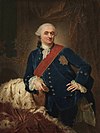
|
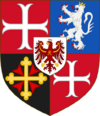
|
2 January 1593 Aquilanida Son of Belandra II and Albert, Duke of Rahdenburg-Ansbach |
Leonore of Larache Cathedral of the Holy Nativity DATE 7 children |
6 April 1641 Palis Royal aged 41 |
Son of Elissa II |
| Rainier II Frederick Rainier Otto Leopold 6 April 1641 – 7 June 1644 |

|
1 January 1618 Aquilanida Son of Jordan VI and Leonore of Larache |
Unmarried | 7 June 1644 Palis Royal aged 26 |
Son of Jordan VI | |
| Melisende I Melisende Elisabetta Marguerite 7 June 1644 – 28 February 1680 |

|
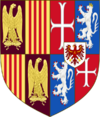
|
19 July 1619 Palis Royal Daughter of Jordan VI and Leonore of Larache |
Constantine XVII Aemilius Sancta Sapientia 1 August 1635 4 children |
28 February 1688 Castra Rubea aged 60 |
Sister of Rainier II |
Titles
The first title utilized by the family was count of Rahden, which served as the primary title of the Head of the House of Rahdenburg since the late 10th century. While the title is no longer in use among dynasts, it later served as a courtesy title for younger sons of the margrave or lesser members of the family. At times, it has also been used by recognized illegitimate members of the family.
Since the late 17th century, the main title utilized by the Head of the House of Rahdenburg is Elector of Rahdenburg, providing the Head of the House with a vote in all royal elections since the separation of Garima from the Holy Audonian Empire, except for the royal elections in 1950 and 1974.
Numerous other titles were inherited by members of the family over the years, including King/Queen of Sydalon, Prince of Schaumberg,Duke of Neuenburg, and Duke of Kostriz, among others.







